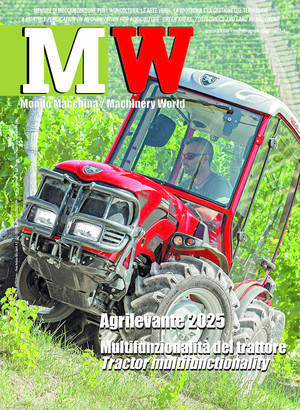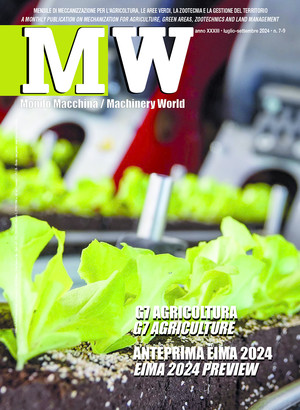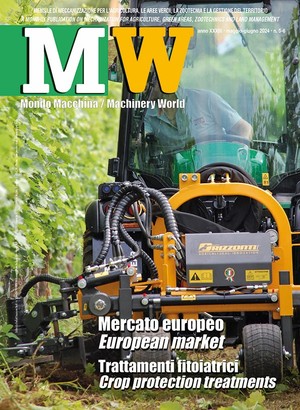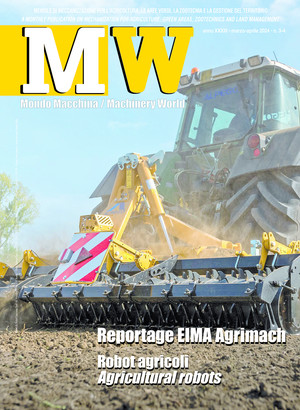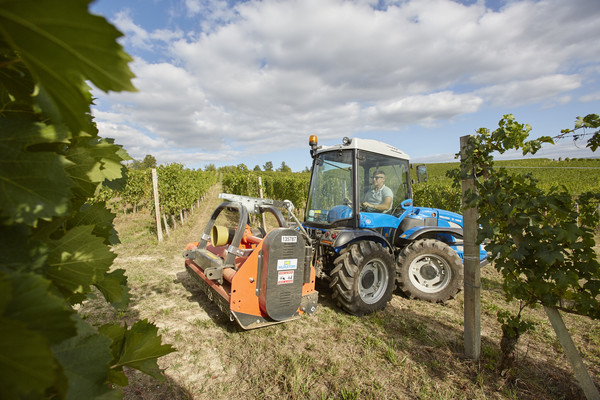
Tractor maneuverability in narrow areas
The continuous increase in power and in the size of tractors and self-propelled machinery is facing growing challenges due to the limited maneuvering space available on many farms and, more critically, the dimensions of private and public roads. Manufacturers are developing technologically enhanced solutions to achieve increasingly tighter turning radii
The progressive (and seemingly unstoppable) increase in the power of tractors, as well as that of many self-propelled machines, which has characterized the last decades of agricultural mechanization, has led to an inevitable increase in the size of these machines. However, this trend has reached an insurmountable limit, at least in several countries of the so-called old continent, due to the limited open spaces in many business centers, but above all due to the unchanged dimensions of the roads, both farm roads and those open to vehicular traffic. The most compelling fact is undoubtedly the maximum ordinary width of vehicles allowed on ordinary roads, which the Italian Highway Code sets at 2.55 meters.
Operational requirements. This situation has forced manufacturers of high-powered tractors to continuously improve the maneuverability of their vehicles, developing original solutions to achieve this goal, sometimes even rather complex in terms of construction. Vehicles with limited power, and therefore smaller in size, have also shown the same need, considering that easy mobility in confined spaces improves theirs in all those situations in the field where this is critical, such as in the very narrow headlands of vineyards and orchards, and when traveling along certain narrow and steep roads within the farm. Numerous and quite different solutions have, therefore, been developed, especially in recent times, all aimed at the same purpose. Without claiming to be exhaustive, the following is an overview of some of the most popular ones.
High steering angles. On the market for some years now, New Holland's SuperSteer allows the front axle to rotate together with the wheels when steering, thus obtaining a very wide total angle (up to 76°). Kubota's Bi-speed achieves a similar result but with a different technical solution, where an increase in the rotation speed of the wheel steering outside the curve has been chosen in order to "close" the trajectory. Thanks to special oil-immersed multidisc clutches, when the steering angle of the inner wheel exceeds 30°, the peripheral speed of the outer wheel automatically increases by a factor of 1.7-1.9, depending on the model. According to Kubota, the reduction in the turning radius compared to an equivalent traditional steering system is 18-20%.
Steering wheels, central joint or both? As an alternative to the classic front steering wheels on isodiametric tractors with limited power, suitable for specialized use, as well as on a few other models, an alternative solution has been developed for several decades, which involves a sturdy central joint (or articulation), often of the cardan type, which connects the front part of the machine (the front axle) to the rear part (the rear axle).
This configuration is made possible by the architecture of this category of tractors, which features a cantilevered engine block at the front. This is a technical choice that presents several challenges, not least of which are transferring power mechanically to the rear wheels and, similarly, transferring power hydraulically to the rear linkage and hydraulic outlets.
The "Dualsteer" system developed by BCS in Abbiategrasso (MI) and extended to some of the group's models is an efficient solution for further reducing the turning radius. The basic principle is simple: combine the two steering solutions described above, i.e., the central articulation and the classic front steering wheels, on the same machine, to obtain an overall angle of 70°. From an operational point of view, attention was focused on controlling the proportionality of the two devices, managed by a hydraulic circuit that acts on the two steering cylinders of the central articulation and on those of the front axle, integrated by an appropriate mechanical connection for synchrony and progressive steering.
The extremely small turning radius allows in many typical situations of specialized cultivations to go directly from one row to the adjacent one with a single turn without the need for further maneuvers. The advantage is tangible: the isodiametric Volcan model by BCS with Dualsteer, equipped with 280/70R18 tires, has a minimum turning radius of 2.20 m (compared to 3.24 m with only the front steering wheels and 2.70 m when only the central articulation is mounted). All this translates into a double advantage: time, especially if you consider that these maneuvers must be repeated several dozen times a day, and less fatigue (both physical and mental) for the driver, who can thus remain alert and vigilant in the demanding task of driving the tractor-implement combination, especially when there is a lot of equipment and the inter-row width is reduced.
Furthermore, the reduced travel at the headland means less compaction and less damage to the turf, if present. Furthermore, if the rows of the vineyard or orchard are arranged in a spiral pattern, even when fully steered during turning maneuvers, the tractor's center of gravity always remains within the support polygon of the 4 wheels, thus guaranteeing a high level of stability.
Four-wheel steering. Derived from the automotive industry, four-wheel steering tractors have also been appearing for some time now. This solution was implemented for the first time on a specialized tractor by the Same Deutz-Fahr group on the Same Frutteto model. With 4WS (4 Wheel Steering), not only the front wheels but also the rear wheels can be steered up to an angle of 20°; their position is constantly controlled by an electronic control unit, which manages three different operating modes, which can be selected alternatively, namely: the classic configuration with only two front steering wheels; four counter-phase steering wheels, to reduce the turning radius by up to 28%; the "crab" mode, with all wheels pointing in the same direction, useful for repeated maneuvers in the center of the farm, but also to effectively counteract sliding downhill when working along the slope.
Thanks to the experience gained in the design and production of vehicles for other sectors, the Austrian company Lindner has developed a rear steering axle for its Lintrac range of open field tractors, using hydraulic steering tie rods in a special alloy, for a maximum angle of 20°, combined with the front axle, which reaches a maximum steering angle of 52°.
Thanks to the solution described, with 420/65-R20 tires in the front and 480/70-R28 tires in the rear, the Lintrac 90 Vineyard has a minimum turning radius of just 3.5 meters. Obviously, in this case, crab steering can be activated, too.
Steering adjustments. The best level of maneuverability of the tractor-operator combination obviously varies according to the operating situation; it is quite clear that it is very different to maneuver to reverse in tight spaces rather than having to constantly maintain the correct direction of travel on the road, traveling at high speed.
To optimize the use of the steering in all conditions, on the most advanced models, there are assorted options available, usually through appropriate programming with the onboard computer. The most common one is the reduction, up to a halving, of the steering wheel turns needed to steer the front wheels from one extreme to the other. Usually, this operation requires 4-4.5 rotations, but these can be significantly reduced by activating a dedicated control. Basically, it is a valuable aid to speed up (and make less tiring) maneuvers carried out in confined spaces that require numerous U-turns.
This function can also be automated, in the sense that at high operating speeds, usually over 20 km/h, the steering reduces its sensitivity so as to be able to maintain a correct line of travel for the vehicle with minimal movements of the steering wheel, without having to be forced to correct the steering angle continuously.
Alternatively, it is also possible to adjust the resistance to the rotation of the steering wheel, or rather the force required to operate this control; this function is commonly implemented on the most recent car models, where at high speeds, the steering "hardens," to allow better control of the vehicle.
On some tractor models, this function can be programmed by the driver so that the operating force can be adapted to personal needs.
All this is possible thanks to the flexibility of the hydraulic drive calibration, which, through a system of valves and with the assistance of a dedicated electronic control unit, manages the flow of oil to the steering pump with extreme precision, both in terms of flow rate and response times.
The turning radius (or diameter)
This is also established by the regulation implementing the Highway Code in art. 217 (Vehicles' ability to take bends - Overall width): “Every motor vehicle, or combination of vehicles, including its load, must be able to fit within a circular area (the clearance zone) with an external radius of 12.50 m and an internal radius of 5.30 m (...). This is, therefore, a particularly important parameter for the circulation of vehicles, both on public roads and in restricted areas, because it affects the design of residential, commercial and industrial buildings, influencing the maneuverability of vehicles in and around these structures. The technical parameter considered in these cases is the so-called "turning radius (or diameter, which is double)," which is, in fact, the measurement of the radius of the imaginary circle that the vehicle covers when the angle of the steered wheels is at a maximum. Basically, it is the minimum space, measured with reference to the outer wheels, of the path followed by the vehicle when it turns at full lock. From this, we can deduce that the turning radius is directly related to the wheelbase of the vehicle, the track and the maximum angle that the steered wheels assume in relation to the longitudinal axis of the vehicle. Measuring it is relatively simple and consists of covering the tread of the outer tires with a contrast medium that is visible on the surface being traveled, such as powdered chalk (or even just water) when the vehicle travels along a curved path with the steering wheel turned as far as possible in one direction (and then in the other), completing a full rotation. By halving the precise measurement of the outer diameter of the circumference thus created, the desired value is obtained.
Four-wheel steering on other self-propelled vehicles for agricultural use
Not only tractors but also other self-propelled machines used in agriculture make profitable use of the 4-wheel steering architecture. For instance, this solution has been systematically adopted for some time now on telescopic handlers, including models intended for agricultural use, which very often operate in confined spaces, inside farm buildings, in protected setups, etc. For example, all the models in the agricultural range of Merlo SpA of S. Defendente di Cervasca (CN) are equipped with three steering modes (two-wheel steering, four-wheel steering, and crab steering). The same functions are available on self-propelled forage harvester wagons but with even more stringent requirements, given that these machines are designed to operate exclusively in the farmyard and are often characterized by very large dimensions. Faresin Industries of Breganze (VI) has been producing various models of 4-wheel drive forage mixer wagons for some years now, which also use the three different steering modes mentioned above. In particular, with 4-wheel steering, a 15% reduction in the turning radius is achieved.


